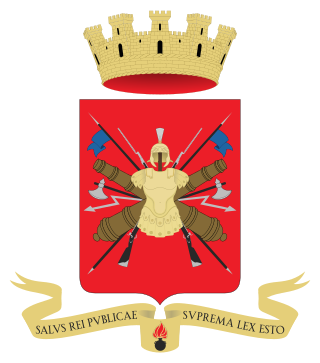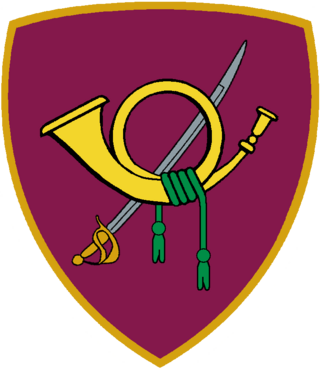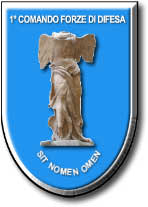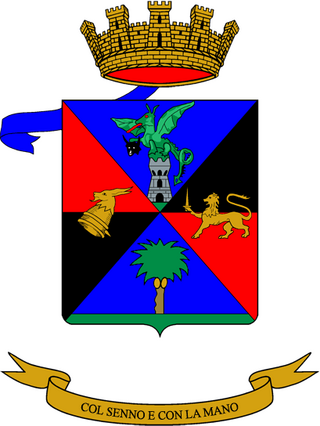Related Research Articles

The Italian Army is the land force branch of the Italian Armed Forces. The army's history dates back to the Italian unification in the 1850s and 1860s. The army fought in colonial engagements in China, Libya, Northern Italy against the Austro-Hungarian Empire during World War I, Abyssinia before World War II and in World War II in Albania, Balkans, North Africa, the Soviet Union, and Italy itself. During the Cold War, the army prepared itself to defend against a Warsaw Pact invasion from the east. Since the end of the Cold War, the army has seen extensive peacekeeping service and combat in Afghanistan and Iraq. Its best-known combat vehicles are the Dardo infantry fighting vehicle, the Centauro tank destroyer and the Ariete tank and among its aircraft the Mangusta attack helicopter, recently deployed in UN missions. The headquarters of the Army General Staff are located in Rome opposite the Quirinal Palace, where the president of Italy resides. The army is an all-volunteer force of active-duty personnel.

The Cavalry Brigade "Pozzuolo del Friuli" is a brigade of the Italian Army, based in the Friuli-Venezia Giulia and Veneto regions. The Brigade consists of a command unit, a cavalry regiment, an amphibious infantry regiment, an artillery regiment, an engineer regiment and a logistic regiment.

The Mechanized Brigade "Granatieri di Sardegna" is a mechanized infantry brigade of the Italian Army, based in Rome and central Italy. The brigade fields one of the oldest regiments of the Army and is one of the guard regiments of the President of Italy. The name of the unit dates back to the Kingdom of Sardinia and not the eponymous Mediterranean island of Sardinia. The brigade is part of the Division "Acqui".

The Bersaglieri Brigade "Garibaldi" is a mechanized infantry brigade of the Italian Army, based in the south of the country. Its core units are Bersaglieri, an elite infantry corps of the Italian Army. The brigade is named after Giuseppe Garibaldi, a hero of the Italian wars of unification. The brigade is part of the Division "Acqui".

The 131st Armored Division "Centauro" was an armored division of the Italian Army during World War II. The division was formed in April 1939 by expanding the I Armored Brigade. The division's name came from the mythological race of half human-half horse creatures named Centaurs. The division participated in the invasion of Albania, Greco-Italian War, and invasion of Yugoslavia. In August 1942 the division was sent to Libya to participate in the Western Desert Campaign. After the Axis defeat at the Second Battle of El Alamein the division retreated with the German-Italian Panzer Army to Tunisia, where the division participated in the Tunisian Campaign. On 18 April 1943 the division was disbanded due to the losses suffered in the Battle of El Guettar.

The 136th Armored Legionary Division "Centauro" was an armored division of the Royal Italian Army during World War II. The division had been formed in June 1942 as 1st CC.NN. Armored Division "M", but was renamed after the fall of the fascist regime in July 1943. In September 1943 it was in training near Rome and was disbanded by the Germans after the announcement of the Armistice of Cassibile.

After World War II the Italian Army had two units named "Centauro": from 1952 to 1986 the Armored Division "Centauro" and from 1986 to 2002 the Armored Brigade "Centauro". Both units were successor to the World War II era 131st Armored Division "Centauro". The units' name came from the mythological race of half human-half horse creatures named Centaurs.

The Mechanized Brigade "Goito" was a mechanized brigade of the Italian Army. Its core units were mechanized Bersaglieri battalions. The brigade's headquarters was in the city of Milan. The brigade's name was chosen in memory of the First Italian War of Independence Battle of Goito, where the Bersaglieri corps had its baptism of fire.

The III Army Corps was one of three corps the Italian Army fielded during the Cold War. Based in the regions of Lombardy and Piedmont the corps was the army's operational reserve, while the 4th Alpine Army Corps and the 5th Army Corps, both based in the North East of Italy, were the army's front-line units. After the end of the Cold War the corps was reduced in size and on 1 December 2000 it ceded its last brigades to the 1st Defence Forces Command. The personnel of the 3rd Army Corps was used to raise the NATO Rapid Deployable Italian Corps in January 2001.

The V Army Corps was one of three corps the Italian Army fielded during the Cold War. Based in the regions of Veneto and Friuli-Venezia-Giulia the corps was the army's main combat force. The 5th Army Corps was arrayed close to the Yugoslavian border and tasked with meeting any Warsaw Pact forces that crossed the border. On the left flank of the corps the 4th Alpine Army Corps was tasked with blocking the Alpine passes and in the rear of the corps the 3rd Army Corps served as operational reserve. After the end of the Cold War the corps was reduced in size and on 1 October 1997 it became the 1st Defence Forces Command. In 2013 the COMFOD 1° was disbanded and its function and brigades taken over by the 20th Infantry Division Friuli in Florence.

The Mechanized Brigade "Legnano" was a mechanized brigade of the Italian Army. Its core units were mechanized infantry battalions. The brigade's headquarters was in the city of Bergamo in Lombardy. The name of the brigade commemorates the Lombard League victory in the Battle of Legnano in 1176 and its coat of arms depicts the Monument to the Warrior of Legnano in the centre of Legnano.

The Regiment "Lancieri di Montebello" (8th) is a cavalry unit of the Italian Army based in Rome. The regiment is the reconnaissance unit of the Mechanized Brigade "Granatieri di Sardegna" and performs public duties in Rome. The regiment was formed after the Second Italian War of Independence and participated in the Third Italian War of Independence. In World War I the regiment fought dismounted on the Italian front. After the war the regiment was disbanded. During World War II the regiment was reformed and during World War II. After the announcement of the Armistice of Cassibile by the regiment fought against invading German forces at the outskirts of Rome, which earned the regiment a Silver Medal of Military Valor. The regiment was reformed in 1951 and has served since then as one of the guard units of Rome. In 1997 the regiment became the reconnaissance unit of the Mechanized Brigade "Granatieri di Sardegna".

The Regiment "Lancieri di Novara" (5th) is a cavalry unit of the Italian Army based in Codroipo in Friuli-Venezia Giulia. The regiment is the reconnaissance unit of the 132nd Armored Brigade "Ariete".

The 31st Tank Regiment is an inactive tank regiment of the Italian Army, which was based in Lecce in Apulia and last operationally assigned to the Mechanized Brigade "Pinerolo". The regiment was formed in July 1937 by the Royal Italian Army and assigned to the I Armored Brigade. In April 1939, the regiment moved from Siena to Tirana in occupied Albania. In winter 1940-41 the regiment fought in the Greco-Italian War and in 1941 it participated in the Invasion of Yugoslavia. In November 1942, the regiment was sent to Libya, where it fought in the Western Desert campaign and then in the Tunisian campaign. In April 1943 the regiment was disbanded due to the heavy losses it had suffered in the Battle of El Guettar. The regiment was immediately reformed in Italy, but it saw no further action, until German forces disbanded it after the announcement of the Armistice of Cassibile on 8 September 1943.

The 131st Tank Regiment is an inactive tank regiment of the Italian Army, which was based in Persano in Campania and last operationally assigned to the Bersaglieri Brigade "Garibaldi". The regiment was formed in July 1941 by the Royal Italian Army and assigned for a short time to the 131st Armored Division "Centauro". In January 1942, the regiment became an autonomous unit and was transferred to Sicily, where it fought against allied forces, which had landed on the island on 9 July 1943. The remnants of the regiment were disbanded by German forces after the Armistice of Cassibile was announced on 8 September 1943.
The L Special Brigade was an infantry brigade of the Royal Italian Army formed for the Tunisian campaign in World War II.

The 131st Engineer Battalion "Ticino" is an inactive military engineering unit of the Italian Army last based in Novara in Piedmont. The battalion was formed in 1958 and assigned to the Armored Division "Centauro". In 1975, the battalion was named for the Ticino river and received the number 131st, which had been used by the 131st Engineer Company that served with the 131st Armored Division "Centauro" during the Tunisian campaign in World War II. With the name and number the battalion was also assigned the flag and traditions of the 9th Engineer Regiment, which had been active between 1926 and 1943. In 1986, the Armored Division "Centauro" was disbanded and the battalion was assigned to the 3rd Army Corps. In 1993, the battalion was disbanded and part of its personnel joined the 10th Engineer Regiment. The battalion's anniversary falls, as for all engineer units, on 24 June 1918, the last day of the Second Battle of the Piave River.

The 9th Artillery Regiment "Pistoia" is an inactive field artillery regiment of the Italian Army, which was based in Vercelli in Piedmont. The regiment was formed in 1861 by the Royal Italian Army and fought in 1866 in the Third Italian War of Independence. During World War I the regiment served on the Italian front. In 1935 the regiment was assigned to the 11th Infantry Division "Brennero". In December 1940 the division was transferred to Albania for the Greco-Italian War. After the German invasion of Greece in April 1941 the division remained in Greece on occupation duty until February 1943, when it moved to Albania to be reorganized as a motorized division. The division and its regiments dissolved after the announcement of the Armistice of Cassibile on 8 September 1943.

The 12th Heavy Field Artillery Regiment is an inactive artillery regiment of the Italian Army, which was based in Vercelli in Piedmont and assigned to the 3rd Army Corps. Originally an artillery regiment of the Royal Italian Army, the regiment was formed in 1920 with pre-existing groups, which had fought during World War I on the Italian front. During World War II the regiment formed an army corps artillery grouping, which in 1943 fought against the allies during the invasion of Sicily. The regiment and its depot were lost when allied forces entered Palermo on 22 July 1943, while the grouping was disbanded in August 1943 after it had retreated from Sicily to Calabria in Southern Italy.